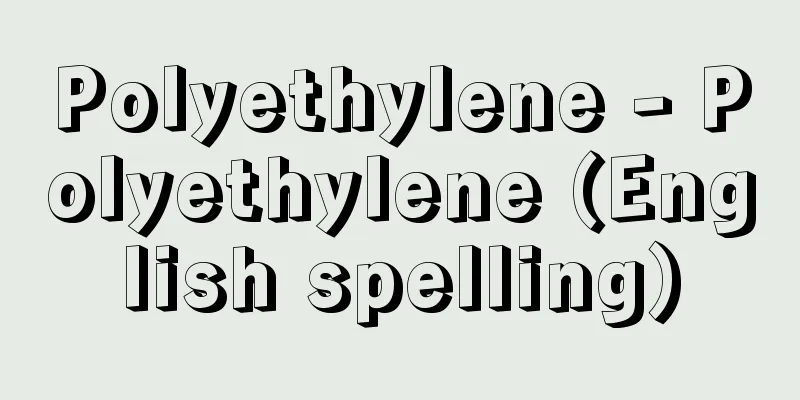Polyethylene - Polyethylene (English spelling)

|
Originally, it meant any polymer of ethylene CH2 = CH2 , but now it only refers to the high polymer used in plastics. It is one of the four major plastics, along with polypropylene, polyvinyl chloride, and polystyrene. It is abbreviated as PE. Ethylene is obtained by cracking natural gas or petroleum (decomposing heavy petroleum to produce light petroleum with a low boiling point). Different methods of polymerization of ethylene produce polyethylene with different properties. Usually, they are distinguished by their density values, but they can also be named after the inventors of the polymerization method or the characteristics of the method. [Hiroshi Kakiuchi] Classification and manufacturing methodIt is generally classified into three types. According to the Japanese Industrial Standards (JIS), low density (LDPE = Low Density Polyethylene) and medium density products are soft, while high density (HDPE = High Density Polyethylene) is hard. [Hiroshi Kakiuchi] Low Density PolyethyleneIt is also called high-pressure polyethylene because a very small amount of oxygen is added to ethylene as a catalyst and polymerized at high pressures of 1,000 to 2,000 atmospheres and temperatures of 100 to 300°C. This manufacturing method was developed by ICI in the UK in 1939 and is also called the ICI process. Furthermore, an ultra-high pressure process (7,000 atmospheres) was developed by DuPont in the US. The ICI process and its improved versions are the mainstream in Japan, with approximately 1.79 million tons produced in fiscal year 2002 (Heisei 14). [Hiroshi Kakiuchi] Medium Density PolyethyleneA well-known method is that of BASF of Germany, which uses benzoyl peroxide as an initiator and polymerizes at about 500 atmospheric pressure and 115 to 120°C. There is also a method of blending high-density and low-density materials. [Hiroshi Kakiuchi] High Density PolyethyleneA special organometallic catalyst (Ziegler-Natta catalyst) is used to polymerize at normal pressure or around 10 atmospheres, at 60-80°C. This is known as the low pressure method. In addition, the American company Phillips has developed a medium pressure method that uses a chromia-alumina catalyst at 30-40 atmospheres and 100-170°C, and a medium pressure method called the Standard Company method that uses a molybdate-alumina catalyst. In Japan, it is also produced by a few chemical companies. HDPE production volume in 2002 was approximately 1.18 million tons. [Hiroshi Kakiuchi] Manufacturing process developmentVarious polyethylene manufacturing processes have been described above, but since around 1997, the following new processes have been developed. (1) The high-pressure process for producing low-density polyethylene is characterized by a short reaction time of 20 to 120 seconds. However, because of the high pressure equipment, the equipment and operating costs are high, so it has been replaced by a conversion process for producing linear low-density polyethylene (LLDPE) using medium and low pressure methods. (2) Medium-low pressure slurry polymerization has become a mature method for producing high density polyethylene. Slurry polymerization is a method in which polymerization is carried out below the melting point of the polymer in a slurry state (a suspension in which insoluble solids are broken down and dispersed in a liquid) in which the polymer does not melt. Ziegler or chromium-based Phillips catalysts are used as catalysts. (3) Solution polymerization is a method of polymerizing a monomer by dissolving it in a solvent, but it is also an effective method for copolymerizing ethylene with other monomers (polymerization using two or more types of monomers), and is also a process for manufacturing ultra-low density polyethylene (ULDPE). A large amount of energy is required to recover the solvent after the reaction is completed. (4) Gas-phase polymerization (polymerization that proceeds in a gaseous monomer) using medium to low pressure methods has been developed to produce polyethylene of various densities. Although the reaction time is long and the reaction rate is low, this method is attracting attention as a method for producing polyethylene of various grades from high density to low density. Metallocene catalysts are a highly active catalyst for Ziegler-Natta catalysts. This catalyst system, discovered in 1980 by Walter Kaminsky, a professor at the University of Hamburg, uses methylalumoxane as a co-catalyst for a metallocene compound represented by zirconocene dichloride. This catalyst system is soluble in organic solvents, has high polymerization activity, and produces polyethylene with a narrower molecular weight distribution than conventional methods, as well as excellent physical properties. [Hiroshi Kakiuchi] naturePolyethylene has different molecular structures depending on the molecular weight and polymerization method, and therefore different properties. Molecular weights range from several thousand to several hundred thousand, and especially those produced by the ultra-high pressure method have molecular weights of over one million. Furthermore, low-density polyethylene molecules are not linear, but branched in places. Since they are not regularly arranged, they are not easily crystallized, and are soft. High-density polyethylene is mostly orderly linear, so there are many crystalline parts, and it is hard. Since the end of each chain is a methyl group -CH3 , the number of methyl groups in the molecule indicates the degree of branching. High-density polyethylene has a softening temperature 30°C higher than low-density polyethylene, and also has greater mechanical strength. However, low-density polyethylene is superior in terms of ease of processing into films or extrusion into tubes, flexibility of the film, transparency, etc., so it is selected according to the application. The general properties of polyethylene are that it is milky white and translucent, lighter than water, and when burned, it drips off like paraffin. It has excellent water resistance, electrical insulation, and resistance to acids and alkalis. It also has good thermal stability and is easy to mold. Its disadvantages include its low softening point and its chemical inertness, which makes it difficult to print or glue directly onto it. Welding methods are used instead of gluing. This includes the heat welding method, which makes use of the properties of thermoplastic resins, which are heating → melting/cooling → solidification. These methods include the hot plate welding method, in which a hot plate is brought into direct contact with the plastic, and the vibration welding method, in which vibration is applied and the resulting frictional heat melts and bonds the plastic. [Hiroshi Kakiuchi] ApplicationsIt is the most widely produced plastic, with domestic production reaching approximately 3.18 million tons in 2002. Its uses are diverse, including films, sheets, bottles, tanks and other hollow containers, pipes, electrical wire coverings for undersea cables and telephone wires, high-frequency insulating materials for radios, televisions, radars, and synthetic fibers. [Hiroshi Kakiuchi] "Plastics Technology Encyclopedia 8: Polyethylene Resins" (1970), edited and published by the Industrial Research Institute" ▽ "Industrialization Process" by Hiroo Tsujikawa et al. (1987, Nikkan Kogyo Shimbun)" ▽ "Copolymerization 3: Engineering Analysis" edited by the Society of Polymer Science (1987, Baifukan) ▽ "High-Strength, High-Modulus Fibers" by Toshio Kunugi et al. (1988, Kyoritsu Shuppan) ▽ "Plastics Recycling: From Recovery to Regeneration" edited by RJ Ehrig, translated by the Plastics Recycling Study Group (1993, Industrial Research Institute) ▽ "Making Films" by Kiyoichi Matsumoto (1993, Kyoritsu Shuppan) ▽ "Chemistry of Polymer Structural Materials" by Yoshio Imai and Kaoru Iwata, edited by the Chemical Society of Japan (1998, Asakura Shoten) ▽ "New Polymers Made with Metallocene Catalysts: New Product Development and Productivity Improvement" by Kimie Komatsu et al. (1999, Industrial Research Institute) ▽ "Metallocene Catalysts and the Outlook for Next-Generation Polymers" edited by Kazuo Soga (2001, CMC) "Polyethylene Technology Reader: Advances in Catalysts and Manufacturing Processes and Material Innovation" edited by Kazuo Matsuura and Naotaka Mikami (2001, Industrial Research Institute) [References] | | | | | | | | |Source: Shogakukan Encyclopedia Nipponica About Encyclopedia Nipponica Information | Legend |
|
本来はエチレンCH2=CH2の重合体(ポリマー)すべてをさすが、現在ではプラスチックなどに用いられる高重合体のみをいう。ポリプロピレン、ポリ塩化ビニル、ポリスチレンとともに、四大プラスチックの一つ。PEと略称される。エチレンは天然ガスや石油のクラッキング(重質石油を分解して沸点の低い軽質石油を製造すること)で得ている。エチレンの重合方法によって性質の異なったポリエチレンになる。普通は密度の値で区別しているが、重合法の発明者の名前や、方法の特徴などでよばれることもある。 [垣内 弘] 分類と製法一般に3種類に分類される。日本工業規格(JIS(ジス))では、低密度(LDPE=Low Density Polyethylene)および中密度品は軟質で、高密度品(HDPE=High Density Polyethylene)は硬質としている。 [垣内 弘] 低密度ポリエチレンエチレンにごく少量の酸素を触媒として加え、1000ないし2000気圧の高圧、100~300℃の温度で重合させるので、高圧法ポリエチレンともいわれる。この製法はイギリスのICI社が開発した方法(1939)で、ICI法ともいわれる。さらに超高圧法(7000気圧)がアメリカのデュポン社で開発されている。日本ではICI法とその改良法が主流で、2002年度(平成14)に約179万トン生産されている。 [垣内 弘] 中密度ポリエチレン過酸化ベンゾイルを開始剤として約500気圧、115~120℃で重合させるドイツのBASF社の方法が有名である。高密度のものと低密度のものとをブレンドする方法もある。 [垣内 弘] 高密度ポリエチレン特殊な有機金属触媒(ツィーグラー‐ナッタ触媒)を用い、常圧ないし10気圧程度、60~80℃で重合させる。低圧法といわれている。またアメリカのフィリップス社では30~40気圧、100~170℃でクロミア‐アルミナ系触媒を用いる中圧法、モリブデン酸‐アルミナ系触媒を用いるスタンダード社法という中圧法などが開発されている。日本でも二、三の化学会社で生産されている。HDPEの生産量は2002年度で約118万トンである。 [垣内 弘] 製造プロセスの発展各種のポリエチレン製造プロセスを述べたが、1997年ごろから以下のような新しいプロセスの発展がみられる。 (1)低密度ポリエチレンをつくる高圧法プロセスは、反応時間が短いことが特徴で、20~120秒である。しかし高圧設備のため設備費や運転コストが高く、中低圧法の直鎖状低密度ポリエチレン(LLDPE)を製造する転換プロセスに置きかわっている。 (2)高密度ポリエチレンの製造法として、中低圧法のスラリー重合が成熟してきた。スラリー重合は、重合体の融点以下で、重合体が融解しないスラリー(非溶解性固体を細分化して液体に分散させた懸濁液)の状態で重合を行う方法である。触媒としてツィーグラー系かクロム系フィリップス触媒が使われている。 (3)溶液重合は単量体(モノマー)を溶媒に溶かして重合する方法であるが、エチレンにほかの単量体を共重合(2種類あるいはそれ以上の単量体を用いて行う重合)させるのに有効な方法で、超低密度ポリエチレン(ULDPE)製造のプロセスでもある。反応終了後の溶媒の回収に多量のエネルギーを必要とする。 (4)各種密度のポリエチレンをつくる中低圧法の気相重合(気体状態の単量体中で進行する重合)が開発されている。反応時間が長く反応率が低いが、高密度から低密度までの各種グレードのポリエチレン製造法として注目されている。ツィーグラー‐ナッタ触媒の高活性化触媒としてメタロセン触媒がある。1980年ハンブルグ大学の教授ワルター・カミンスキーWalter Kaminskyにより発見されたジルコノセンジクロリドに代表されるメタロセン化合物にメチルアルモキサンを助触媒とする触媒系で、有機溶媒に可溶で重合活性が高く、従来の方法に比べて分子量分布が狭く、その他の物性面についても優れたポリエチレンを与える。 [垣内 弘] 性質ポリエチレンは、分子量の大小や重合方法によって分子構造が異なり、そのために性質が異なる。分子量は数千から数十万のものがあり、とくに超高圧法では100万以上の分子量をもっている。さらに低密度ポリエチレンの分子は直鎖状でなく、ところどころ分岐している。規則的な配列をしていないため結晶化しにくいので軟らかい。高密度ポリエチレンはだいたい整然とした直鎖状をしているので結晶部分が多く、硬質になる。各鎖の末端はメチル基-CH3であるから、分子中のメチル基の数によって分岐の程度がわかる。高密度のものは低密度のものに比べて軟化温度が30℃も高く、機械的強度も大きい。しかしフィルムにしたりチューブに押し出す加工の容易さ、フィルムのしなやかさ、透明性などは低密度のほうが優れているので、用途に応じて選択される。 ポリエチレンの一般的性質としては、乳白色半透明で水より軽く、燃焼するとパラフィンと同様でぽたぽた落ちていく。耐水性、電気絶縁性、耐酸・耐アルカリ性に優れている。熱安定性もよく成形しやすい。欠点としては、軟化点が低いことと、化学的に不活性のため直接に印刷したり、接着させることがむずかしい、などである。接着のかわりには溶着法を用いる。これには、加熱→溶融/冷却→固化という熱可塑性樹脂の性質を利用した熱溶着法がある。熱板を直接プラスチックに接触させる熱板溶着法、振動を加えその摩擦熱で溶融・接合させる振動溶着法などである。 [垣内 弘] 用途もっとも生産量の多いプラスチックであり、その生産量は日本国内では2002年で約318万トンに達している。用途はフィルム、シート、瓶、タンクなどの中空容器、パイプ、電線被覆として海底電線ケーブルや電話架線、ラジオ、テレビ、レーダーなどの高周波絶縁材料、合成繊維など多方面にわたっている。 [垣内 弘] 『工業調査会編・刊『プラスチック技術全書8 ポリエチレン樹脂』(1970)』▽『辻川浩雄ほか著『工業化プロセス』(1987・日刊工業新聞社)』▽『高分子学会編『共重合3 工学解析』(1987・培風館)』▽『功刀利夫ほか著『高強度・高弾性率繊維』(1988・共立出版)』▽『R. J. Ehrig編著、プラスチックリサイクリング研究会訳『プラスチックリサイクリング――回収から再生まで』(1993・工業調査会)』▽『松本喜代一著『フィルムをつくる』(1993・共立出版)』▽『日本化学会編、今井淑夫・岩田薫著『高分子構造材料の化学』(1998・朝倉書店)』▽『小松公栄ほか著『メタロセン触媒でつくる新ポリマー――新製品の開発・生産性の向上』(1999・工業調査会)』▽『曽我和雄編『メタロセン触媒と次世代ポリマーの展望』(2001・シーエムシー)』▽『松浦一雄・三上尚孝編著『ポリエチレン技術読本――触媒・製造プロセスの進歩と材料革新』(2001・工業調査会)』 [参照項目] | | | | | | | | |出典 小学館 日本大百科全書(ニッポニカ)日本大百科全書(ニッポニカ)について 情報 | 凡例 |
>>: Polyester fibre - polyester fibre
Recommend
Kushida Shrine (Toyama) - Kushida Shrine
...In the Tohoku region, there is also a legend t...
Lake Okutama - Okutama
This is an artificial lake located upstream of th...
Paper Crossing - Kamiwatari
...The number of events increased as it was passe...
Angami - Angami
…They are known for having been almost completely...
Bomarzo Gardens
Located in the small town of Bomarzo, 60km north o...
Book of Durrow
A large medieval parchment illuminated Gospel manu...
Carrom game (English name)
A billiard game that pairs with the pocket game, a...
Kuzu fauna - Kuzu fauna
A general term for a group of fossil vertebrates f...
hauḍ (English spelling) haud
A typical example is the Chahār Bagh (four garden...
Euridice
...As a result, opera was born, and solo singing ...
Manu
…Silver was measured in the form of grains, bars,...
Conscription - Conscription
A type of conscription system in which citizens s...
Swedish School
A school of economics centered around Swedish univ...
Allergic conjunctivitis
What kind of disease is it? ●Main symptoms and pro...
Wilson, H.
…It is not uncommon for players to earn $10 milli...

![Okaya [city] - Okaya](/upload/images/67cb1a37917a4.webp)







